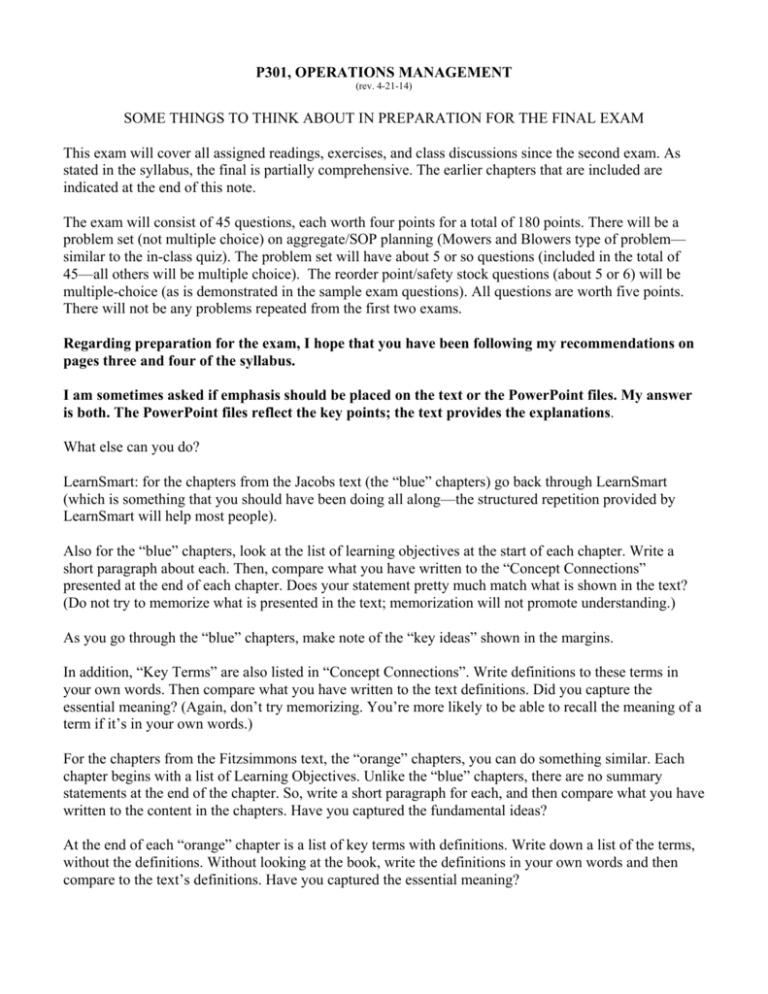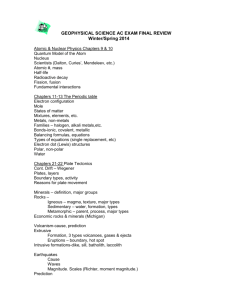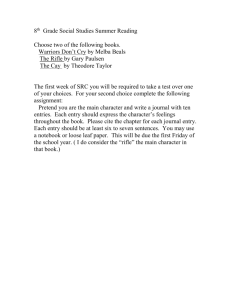P301, OPERATIONS MANAGEMENT SOME THINGS TO
advertisement

P301, OPERATIONS MANAGEMENT (rev. 4-21-14) SOME THINGS TO THINK ABOUT IN PREPARATION FOR THE FINAL EXAM This exam will cover all assigned readings, exercises, and class discussions since the second exam. As stated in the syllabus, the final is partially comprehensive. The earlier chapters that are included are indicated at the end of this note. The exam will consist of 45 questions, each worth four points for a total of 180 points. There will be a problem set (not multiple choice) on aggregate/SOP planning (Mowers and Blowers type of problem— similar to the in-class quiz). The problem set will have about 5 or so questions (included in the total of 45—all others will be multiple choice). The reorder point/safety stock questions (about 5 or 6) will be multiple-choice (as is demonstrated in the sample exam questions). All questions are worth five points. There will not be any problems repeated from the first two exams. Regarding preparation for the exam, I hope that you have been following my recommendations on pages three and four of the syllabus. I am sometimes asked if emphasis should be placed on the text or the PowerPoint files. My answer is both. The PowerPoint files reflect the key points; the text provides the explanations. What else can you do? LearnSmart: for the chapters from the Jacobs text (the “blue” chapters) go back through LearnSmart (which is something that you should have been doing all along—the structured repetition provided by LearnSmart will help most people). Also for the “blue” chapters, look at the list of learning objectives at the start of each chapter. Write a short paragraph about each. Then, compare what you have written to the “Concept Connections” presented at the end of each chapter. Does your statement pretty much match what is shown in the text? (Do not try to memorize what is presented in the text; memorization will not promote understanding.) As you go through the “blue” chapters, make note of the “key ideas” shown in the margins. In addition, “Key Terms” are also listed in “Concept Connections”. Write definitions to these terms in your own words. Then compare what you have written to the text definitions. Did you capture the essential meaning? (Again, don’t try memorizing. You’re more likely to be able to recall the meaning of a term if it’s in your own words.) For the chapters from the Fitzsimmons text, the “orange” chapters, you can do something similar. Each chapter begins with a list of Learning Objectives. Unlike the “blue” chapters, there are no summary statements at the end of the chapter. So, write a short paragraph for each, and then compare what you have written to the content in the chapters. Have you captured the fundamental ideas? At the end of each “orange” chapter is a list of key terms with definitions. Write down a list of the terms, without the definitions. Without looking at the book, write the definitions in your own words and then compare to the text’s definitions. Have you captured the essential meaning? I do not expect you to memorize the exact, text book definitions of terms. If you can define key terms in your own words, and your definition captures the essence of the text book definition, then you should be OK. Do not memorize formulas. Any formulas that you need will be provided. You just have to remember how to use them. Fair enough? When you think that you are ready, try some self-quizzing. To begin with, turn to the detailed table of contents at the beginning of the text. Try writing a short paragraph about each topic and sub-topic? Does what you have written capture the key ideas of each topic and sub-topic? Next, go through the set of sample exam questions that are posted in Resources. These are questions that I have previously used in exams. These will give you a sense of how I write questions. Note that some of my questions about terminology and concepts use examples (in the question or the answer choices) rather than the actual definition. These include a sequence of multiple choice questions for a project management problem (again, formatted as you will see on the exam). This set will also include a forecasting problem set using the same format as will be used on the exam. Also go through the multiple choice quizzes for the Fitzsimmons “orange’ chapters. These are found in the student web site for Fitzsimmons; the link to this site appears in Resources. Here are some additional comments by chapter. Blue 19 pages 505-521 (custom 18) Sales and Operations Planning (aggregate planning). As noted above, there will a problem set similar to the in-class quiz. Beyond this, you should be familiar with the management issues, the various production planning strategies, and yield management. MRP and dependent demand. Remember the class room discussion and demonstration of MRP logic for calculating dependent demands. Blue 14 pages 402-419 (custom 15) Lean Supply Chains. The focus is on the philosophy of lean. Review the PP file, which included material not in the book. (During the semester, I edited this PP file to eliminate the section on Theory of Constraints, which appeared at the end of this file. If you made a hard copy before the new file was posted, ignore this section.) Ignore the section “Determining the number of Kanbans needed” on pages 411-412. On page 412, the discussion, and graphs, about minimized setup times is a variation of the EOQ concept discussed in Blue 20 on inventory management. With regard to value stream mapping, pages 413-415, you only need to be familiar with the concept and how it is used to improve processes. From class lecture: The ICB Portfolio concept. How does this concept illustrate the primary, short-range challenge of balancing demand and supply faced by every business? Blue 10 pages 241-268 (custom 10) Waiting Line Analysis. You do not need to be familiar with the basis of the theoretical formulas (pages 245-6). With regard to the Waiting Line Models (on pages 250-260), look at the formulas for Lq for models 1 and 2. What does this tell you about the effect of supply (or demand) variation on the length of a waiting line? Remember the class room demonstration/discussion using model 1(the graph that you plotted of utilization versus line length). How does utilization relate to line length? What was the shape of the graph and what is its implication? What can a simulation show that the theoretical formulas cannot? You do not need to know the details of the simulation example on pages 261-266. Review the article in Resources The Psychology of Waiting Lines. What actions can be taken to affect customer perceptions while waiting in line? Blue 20 pages 531-557 (custom 19) Inventory Management. While the only problems will be on reorder point and safety stock (the fixed order quantity model), you should be familiar with the concepts underlying the fixed-time period and single-period inventory models. What are the underlying assumptions of each model? What fundamental questions are being addressed by these concepts? You are not responsible for calculations with these two models. There will be no questions on Blue 24, Health Care. From earlier in the course: Blue 12, pages 315-330, Six Sigma Quality. Blue 13, pages 336-355, Statistical Quality Control Orange 6, pages 356-390, Service Quality






